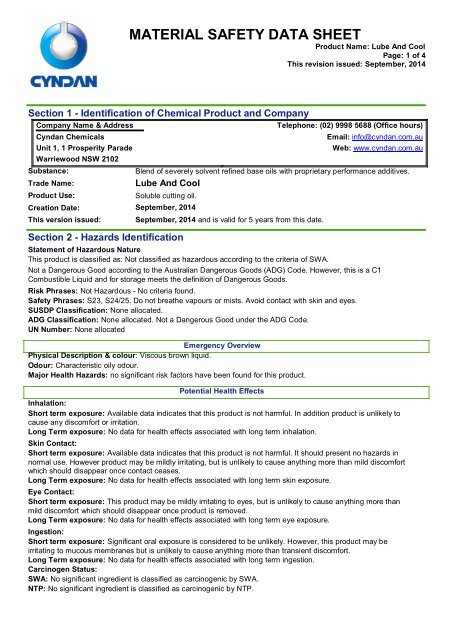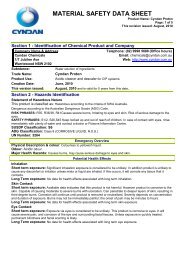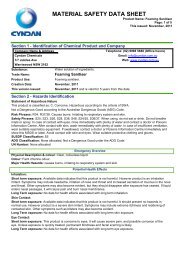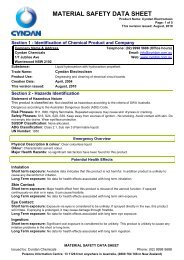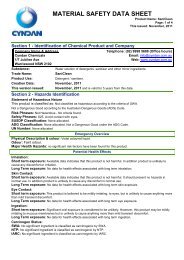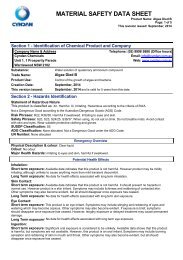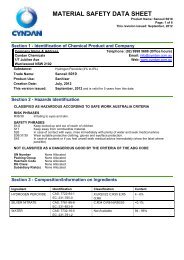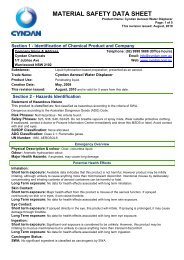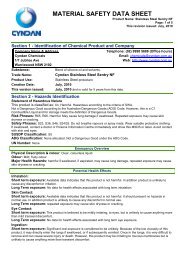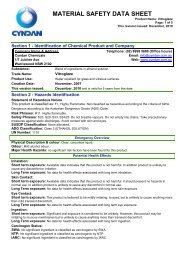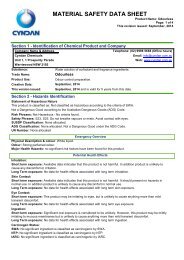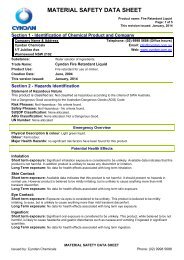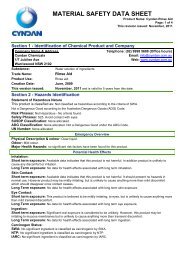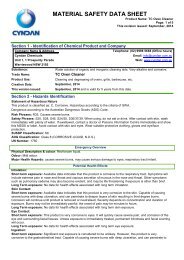Lube & Cool - MSDS - CYNDAN Chemicals
Lube & Cool - MSDS - CYNDAN Chemicals
Lube & Cool - MSDS - CYNDAN Chemicals
You also want an ePaper? Increase the reach of your titles
YUMPU automatically turns print PDFs into web optimized ePapers that Google loves.
MATERIAL SAFETY DATA SHEET<br />
Product Name: <strong>Lube</strong> And <strong>Cool</strong><br />
Page: 1 of 4<br />
This revision issued: September, 2014<br />
Section 1 - Identification of Chemical Product and Company<br />
Company Name & Address<br />
Cyndan <strong>Chemicals</strong><br />
Unit 1, 1 Prosperity Parade<br />
Warriewood NSW 2102<br />
Substance:<br />
Trade Name:<br />
Product Use:<br />
Creation Date:<br />
This version issued:<br />
Telephone: (02) 9998 5688 (Office hours)<br />
Email: info@cyndan.com.au<br />
Web: www.cyndan.com.au<br />
Blend of severely solvent refined base oils with proprietary performance additives.<br />
<strong>Lube</strong> And <strong>Cool</strong><br />
Soluble cutting oil.<br />
September, 2014<br />
Section 2 - Hazards Identification<br />
September, 2014 and is valid for 5 years from this date.<br />
Statement of Hazardous Nature<br />
This product is classified as: Not classified as hazardous according to the criteria of SWA.<br />
Not a Dangerous Good according to the Australian Dangerous Goods (ADG) Code. However, this is a C1<br />
Combustible Liquid and for storage meets the definition of Dangerous Goods.<br />
Risk Phrases: Not Hazardous - No criteria found.<br />
Safety Phrases: S23, S24/25. Do not breathe vapours or mists. Avoid contact with skin and eyes.<br />
SUSDP Classification: None allocated.<br />
ADG Classification: None allocated. Not a Dangerous Good under the ADG Code.<br />
UN Number: None allocated<br />
Emergency Overview<br />
Physical Description & colour: Viscous brown liquid.<br />
Odour: Characteristic oily odour.<br />
Major Health Hazards: no significant risk factors have been found for this product.<br />
Potential Health Effects<br />
Inhalation:<br />
Short term exposure: Available data indicates that this product is not harmful. In addition product is unlikely to<br />
cause any discomfort or irritation.<br />
Long Term exposure: No data for health effects associated with long term inhalation.<br />
Skin Contact:<br />
Short term exposure: Available data indicates that this product is not harmful. It should present no hazards in<br />
normal use. However product may be mildly irritating, but is unlikely to cause anything more than mild discomfort<br />
which should disappear once contact ceases.<br />
Long Term exposure: No data for health effects associated with long term skin exposure.<br />
Eye Contact:<br />
Short term exposure: This product may be mildly irritating to eyes, but is unlikely to cause anything more than<br />
mild discomfort which should disappear once product is removed.<br />
Long Term exposure: No data for health effects associated with long term eye exposure.<br />
Ingestion:<br />
Short term exposure: Significant oral exposure is considered to be unlikely. However, this product may be<br />
irritating to mucous membranes but is unlikely to cause anything more than transient discomfort.<br />
Long Term exposure: No data for health effects associated with long term ingestion.<br />
Carcinogen Status:<br />
SWA: No significant ingredient is classified as carcinogenic by SWA.<br />
NTP: No significant ingredient is classified as carcinogenic by NTP.
Product Name: <strong>Lube</strong> And <strong>Cool</strong><br />
Page: 2 of 4<br />
This revision issued: September, 2014<br />
IARC: No significant ingredient is classified as carcinogenic by IARC.<br />
Section 3 - Composition/Information on Ingredients<br />
Ingredients CAS No Conc,% TWA (mg/m3) STEL (mg/m3)<br />
Non hazardous proprietary blend secret 100 not set not set<br />
This is a commercial product whose exact ratio of components may vary slightly. Minor quantities of other non<br />
hazardous ingredients are also possible.<br />
The SWA TWA exposure value is the average airborne concentration of a particular substance when calculated over a normal 8 hour working day<br />
for a 5 day working week. The STEL (Short Term Exposure Limit) is an exposure value that may be equalled (but should not be exceeded) for no<br />
longer than 15 minutes and should not be repeated more than 4 times per day. There should be at least 60 minutes between successive exposures<br />
at the STEL. The term "peak "is used when the TWA limit, because of the rapid action of the substance, should never be exceeded, even briefly.<br />
Section 4 - First Aid Measures<br />
General Information:<br />
You should call The Poisons Information Centre if you feel that you may have been poisoned, burned or irritated by<br />
this product. The number is 13 1126 from anywhere in Australia (0800 764 766 in New Zealand) and is available at all<br />
times. Have this <strong>MSDS</strong> with you when you call.<br />
Inhalation: First aid is not generally required. If in doubt, contact a Poisons Information Centre or a doctor.<br />
Skin Contact: Irritation is unlikely. However, if irritation does occur, flush with lukewarm, gently flowing water for 5<br />
minutes or until chemical is removed.<br />
Eye Contact: No effects expected. If irritation does occur, flush contaminated eye(s) with lukewarm, gently flowing<br />
water for 5 minutes or until the product is removed. Obtain medical advice if irritation becomes painful or lasts more<br />
than a few minutes. Take special care if exposed person is wearing contact lenses.<br />
Ingestion: If product is swallowed or gets in mouth, do NOT induce vomiting; wash mouth with water and give some<br />
water to drink. If symptoms develop, or if in doubt contact a Poisons Information Centre or a doctor.<br />
Section 5 - Fire Fighting Measures<br />
Fire and Explosion Hazards: This product is classified as a C1 combustible product. There is no risk of an<br />
explosion from this product under normal circumstances if it is involved in a fire. Violent steam generation or eruption<br />
may occur upon application of direct water stream on hot liquids. Vapours from this product are heavier than air and<br />
may accumulate in sumps, pits and other low-lying spaces, forming potentially explosive mixtures. They may also<br />
flash back considerable distances.<br />
Fire decomposition products from this product may be toxic if inhaled. Take appropriate protective measures.<br />
Extinguishing Media: Suitable extinguishing media are carbon dioxide, dry chemical, foam, water fog.<br />
Fire Fighting: If a significant quantity of this product is involved in a fire, call the fire brigade. <strong>Cool</strong> closed,<br />
undamaged containers exposed to fire with water spray.<br />
Flash point:<br />
Upper Flammability Limit:<br />
Lower Flammability Limit:<br />
Autoignition temperature:<br />
Flammability Class:<br />
Combustible liquid not meeting the AS 1940 definition of a Flammable Liquid.<br />
No data.<br />
No data.<br />
No data.<br />
C1<br />
Section 6 - Accidental Release Measures<br />
Accidental release: Minor spills do not normally need any special cleanup measures. In the event of a major spill,<br />
prevent spillage from entering drains or water courses. As a minimum, wear overalls, goggles and gloves. Suitable<br />
materials for protective clothing include rubber, PVC. Eye/face protective equipment should comprise as a minimum,<br />
protective glasses and, preferably, goggles. If there is a significant chance that vapours or mists are likely to build up<br />
in the cleanup area, we recommend that you use a respirator. Usually, no respirator is necessary when using this<br />
product. However, if you have any doubts consult the Australian Standard mentioned below (section 8).<br />
Stop leak if safe to do so, and contain spill. Absorb onto sand, vermiculite or other suitable absorbent material. If spill<br />
is too large or if absorbent material is not available, try to create a dike to stop material spreading or going into drains<br />
or waterways. Sweep up and shovel or collect recoverable product into labelled containers for recycling or salvage,<br />
and dispose of promptly. Can be slippery on floors, especially when wet. Recycle containers wherever possible after<br />
careful cleaning. After spills, wash area preventing runoff from entering drains. If a significant quantity of material<br />
enters drains, advise emergency services. This material may be suitable for approved landfill. Ensure legality of<br />
disposal by consulting regulations prior to disposal. Thoroughly launder protective clothing before storage or re-use.<br />
Advise laundry of nature of contamination when sending contaminated clothing to laundry.<br />
MATERIAL SAFETY DATA SHEET<br />
Issued by: Cyndan <strong>Chemicals</strong> Phone: (02) 9998 5688<br />
Poisons Information Centre: 13 1126 from anywhere in Australia, (0800 764 766 in New Zealand)
Product Name: <strong>Lube</strong> And <strong>Cool</strong><br />
Page: 3 of 4<br />
This revision issued: September, 2014<br />
Section 7 - Handling and Storage<br />
Handling: Keep exposure to this product to a minimum, and minimise the quantities kept in work areas. Check<br />
Section 8 of this <strong>MSDS</strong> for details of personal protective measures, and make sure that those measures are followed.<br />
The measures detailed below under "Storage" should be followed during handling in order to minimise risks to<br />
persons using the product in the workplace. Also, avoid contact or contamination of product with incompatible<br />
materials listed in Section 10.<br />
Storage: Note that this product is combustible and therefore, for Storage, meets the definition of Dangerous Goods<br />
in some states. If you store large quantities (tonnes) of such products, we suggest that you consult your state's<br />
Dangerous Goods authority in order to clarify your obligations regarding their storage.<br />
Store packages of this product in a cool place. Make sure that containers of this product are kept tightly closed. Make<br />
sure that the product does not come into contact with substances listed under "Incompatibilities" in Section 10. Check<br />
packaging - there may be further storage instructions on the label.<br />
Section 8 - Exposure Controls and Personal Protection<br />
The following Australian Standards will provide general advice regarding safety clothing and equipment:<br />
Respiratory equipment: AS/NZS 1715, Protective Gloves: AS 2161, Industrial Clothing: AS2919, Industrial Eye<br />
Protection: AS1336 and AS/NZS 1337, Occupational Protective Footwear: AS/NZS2210.<br />
SWA Exposure limits TWA (mg/m3) STEL (mg/m3)<br />
Exposure limits have not been established by SWA for this product.<br />
No special equipment is usually needed when occasionally handling small quantities. The following instructions are<br />
for bulk handling or where regular exposure in an occupational setting occurs without proper containment systems.<br />
Ventilation: No special ventilation requirements are normally necessary for this product. However make sure that<br />
the work environment remains clean and that vapours and mists are minimised.<br />
Eye Protection: Eye protection is not normally necessary when this product is being used. However, if in doubt,<br />
wear suitable protective glasses or goggles.<br />
Skin Protection: The information at hand indicates that this product is not harmful and that normally no special skin<br />
protection is necessary. However, we suggest that you routinely avoid contact with all chemical products and that you<br />
wear suitable gloves (preferably elbow-length) when skin contact is likely.<br />
Protective Material Types: We suggest that protective clothing be made from the following: rubber, PVC.<br />
Respirator: Usually, no respirator is necessary when using this product. However, if you have any doubts consult<br />
the Australian Standard mentioned above.<br />
Section 9 - Physical and Chemical Properties:<br />
Physical Description & colour:<br />
Odour:<br />
Boiling Point:<br />
Freezing/Melting Point:<br />
Volatiles:<br />
Vapour Pressure:<br />
Vapour Density:<br />
Specific Gravity:<br />
Water Solubility:<br />
pH:<br />
Volatility:<br />
Odour Threshold:<br />
Evaporation Rate:<br />
Coeff Oil/water distribution:<br />
Autoignition temp:<br />
Section 10 - Stability and Reactivity<br />
Viscous brown liquid.<br />
Characteristic oily odour.<br />
Not available.<br />
No specific data. Liquid at normal temperatures.<br />
No data.<br />
No data.<br />
No data.<br />
0.89 at 15°C<br />
Emulsifiable.<br />
No data.<br />
No data.<br />
No data.<br />
No data.<br />
No data<br />
No data.<br />
Reactivity: This product is unlikely to react or decompose under normal storage conditions. However, if you have<br />
any doubts, contact the supplier for advice on shelf life properties.<br />
Conditions to Avoid: This product should be kept in a cool place, preferably below 30°C. Keep containers tightly<br />
closed.<br />
Incompatibilities: strong acids, strong bases, strong oxidising agents.<br />
Fire Decomposition: Carbon dioxide, and if combustion is incomplete, carbon monoxide and smoke. Water.<br />
Carbon monoxide poisoning produces headache, weakness, nausea, dizziness, confusion, dimness of vision,<br />
disturbance of judgment, and unconsciousness followed by coma and death.<br />
MATERIAL SAFETY DATA SHEET<br />
Issued by: Cyndan <strong>Chemicals</strong> Phone: (02) 9998 5688<br />
Poisons Information Centre: 13 1126 from anywhere in Australia, (0800 764 766 in New Zealand)
Product Name: <strong>Lube</strong> And <strong>Cool</strong><br />
Page: 4 of 4<br />
This revision issued: September, 2014<br />
Polymerisation: Polymerisation reactions are unlikely; they are not expected to occur.<br />
Section 11 - Toxicological Information<br />
Local Effects:<br />
Target Organs:<br />
Ingredient<br />
Risk Phrases<br />
No ingredient mentioned in the HSIS Database is present in this product at hazardous concentrations.<br />
Section 12 - Ecological Information<br />
Insufficient data to be sure of status.<br />
SWA<br />
CAS number<br />
Hazchem Code<br />
There is no data to hand indicating any particular target organs.<br />
Classification of Hazardous Ingredients<br />
Section 13 - Disposal Considerations<br />
Disposal: This product may be recycled if unused, or if it has not been contaminated so as to make it unsuitable for<br />
its intended use. If it has been contaminated, it may be possible to reclaim the product by filtration, distillation or some<br />
other means. If neither of these options is suitable, consider controlled incineration, or landfill.<br />
Section 14 - Transport Information<br />
ADG Code: This product is not classified as a Dangerous Good. No special transport conditions are necessary<br />
unless required by other regulations.<br />
Section 15 - Regulatory Information<br />
AICS: We are unable to verify that this product is compliant with NICNAS regulations. There are several possible<br />
reasons why this may occur. If you have any reason to be concerned about this, we suggest you call us on the<br />
number below.<br />
Section 16 - Other Information<br />
Acronyms:<br />
ADG Code<br />
AICS<br />
IARC<br />
NOS<br />
NTP<br />
R-Phrase<br />
SUSDP<br />
UN Number<br />
This <strong>MSDS</strong> contains only safety-related information. For other data see product literature.<br />
Australian Code for the Transport of Dangerous Goods by Road and Rail (7th edition)<br />
Australian Inventory of Chemical Substances<br />
Safe Work Australia, formerly ASCC and NOHSC<br />
Chemical Abstracts Service Registry Number<br />
Emergency action code of numbers and letters that provide information to emergency<br />
services especially firefighters<br />
International Agency for Research on Cancer<br />
Not otherwise specified<br />
National Toxicology Program (USA)<br />
Risk Phrase<br />
Standard for the Uniform Scheduling of Drugs & Poisons<br />
United Nations Number<br />
CONTACT POINT<br />
TELEPHONE (Business hours): (02) 9998 5688 Fax: (02) 9999 2086<br />
National Poisons Information Centre:<br />
Dial 13 1126 (from anywhere in Australia)<br />
THIS <strong>MSDS</strong> SUMMARISES OUR BEST KNOWLEDGE OF THE HEALTH AND SAFETY HAZARD INFORMATION OF THE PRODUCT AND<br />
HOW TO SAFELY HANDLE AND USE THE PRODUCT IN THE WORKPLACE. EACH USER SHOULD READ THIS <strong>MSDS</strong> AND CONSIDER THE<br />
INFORMATION IN THE CONTEXT OF HOW THE PRODUCT WILL BE HANDLED AND USED IN THE WORKPLACE INCLUDING IN<br />
CONJUNCTION WITH OTHER PRODUCTS. IF CLARIFICATION OR FURTHER INFORMATION IS NEEDED TO ENSURE THAT AN<br />
APPROPRIATE RISK ASSESSMENT CAN BE MADE, THE USER SHOULD CONTACT THIS COMPANY. THE RESPONSIBILITY FOR<br />
PRODUCTS SOLD IS SUBJECT TO OUR STANDARD TERMS AND CONDITIONS, A COPY OF WHICH IS SENT TO OUR CUSTOMERS AND<br />
IS ALSO AVAILABLE ON REQUEST.<br />
Please read all labels carefully before using product.<br />
This <strong>MSDS</strong> is prepared in accord with the SWA document “National Code of Practice for the Preparation of<br />
Material Safety Data Sheets” 2nd Edition [NOHSC:2011(2003)]<br />
MATERIAL SAFETY DATA SHEET<br />
Issued by: Cyndan <strong>Chemicals</strong> Phone: (02) 9998 5688<br />
Poisons Information Centre: 13 1126 from anywhere in Australia, (0800 764 766 in New Zealand)


